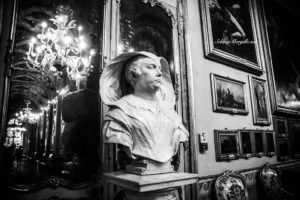Donna Olimpia, the so called “la Pimpaccia”
Italian Version Below*
Who says woman says harm, who says female says bad, who says Olimpia Maidalchina says woman, damage and ruin! (Pasquinata)
In the mid-17th century (the so-called Baroque) undoubtedly in Rome, there were two protagonists: Pope Innocent X Pamphilj (1644-1655) and his sister-in-law Olimpia Maidalchini, born in 1594 in Viterbo and daughter of a powerful businessman.
At 18 years old, this young woman realized that she had to enter into the good graces of Pamphilio Pamphilj, brother of the future Pope Innocent X, aka Giovan Battista Pamphilj. Olimpia Maidalchini, despite the 27 years of difference, married Pamphilio Pamphilii in 1612.
When she was widowed in 1639, Giovan Battista gave her some lands in the Viterbo area including the abbey complex of San Martino al Cimino.
It was Pasquino who nicknamed her “Pimpaccia” deforming the name of “Pimpa” in Romanesque female protagonist of a comedy, with a clever, careerist, despotic and dominating character just like her.
The “misfortune” came when Innocent X died in 1655: it is said that Olimpia woman grabbed money everywhere, stealing two crates full of gold that the Pope had under the bed.
Alexander VII Chigi, having become Pope, exiled her to his villa in San Martino al Cimino; tried in absentia she was sentenced to return the gold booty, but refused. He died due the plague in 1657.
The photographs below refer to the marble bust (Carrara marble) by Alessandro Algardi, visible at the DoriaPamphilj gallery among the greatest portraits of the seventeenth century in Rome.
Olimpia is portrayed with the veil around her head, a symbol of mourning for the death of her husband.
Algardi, a Bolognese sculptor, trained at the Academy of Lodovico Carracci was among the major exponents of the so-called “classicist” school, in stark contrast to the eccentric virtuosity typical of Baroque works.
All rights reserved*
Chi dice donna, dice danno, chi dice femmina dice malanno, chi dice Olimpia Maidalchina dice donna, danno e rovina! (Pasquinata)
La Roma Barocca di metà ‘600 aveva indubbiamente due protagonisti: Papa Innocenzo X Pamphilj (1644-1655) e sua cognata Olimpia Maidalchini, nata nel 1594 a Viterbo e figlia di un potente uomo d’affari.
A 18 anni, questa giovane donna, capì di dover entrare nelle grazie di Pamphilio Pamphilj, fratello del futuro Papa Innocenzo X, al secolo Giovan Battista Pamphilj. Olimpia Maidalchini, nonostante i 27 anni di differenza, sposò Pamphilio Pamphilii nel 1612.
Quando nel 1639 rimase vedova, Giovan Battista le donò alcune terre nel viterbese tra cui il complesso abbaziale di San Martino al Cimino.
Fu Pasquino a soprannominarla “Pimpaccia” deformando in romanesco il nome di “Pimpa” protagonista femminile di una commedia, dal carattere furbo, arrivista, dispotica e dominatrice proprio come era il suo.
La “disgrazia” arrivò quando Innocenzo X morì nel 1655: si racconta che donna Olimpia arraffò denaro ovunque, rubando due casse piene d’oro che il Papa aveva sotto il letto.
Alessandro VII Chigi, divenuto Papa, la esiliò nella sua villa di San Martino al Cimino; processata in contumacia fu condannata a restituire il bottino d’oro, ma si rifiutò. Morì di peste nel 1657.
Le fotografie sotto riportate si riferiscono al busto marmoreo (Marmo di Carrara) di Alessandro Algardi, visibile alla Galleria DoriaPamphilj tra i più grandi ritratti del Seicento romano.
Olimpia è ritratta con il velo che le cinge il capo, simbolo di lutto per la morte del marito.
Algardi, scultore bolognese, formatosi presso l’Accademia di Lodovico Carracci fu tra i maggiori esponenti della c.d. scuola “classicista”, in netta contrapposizione con gli eccentrici virtuosismi tipici delle opere barocche.
Sostieni #laculturachevince, aiuta la condivisione.

